There’s something magical about origami, the Japanese art of paper folding. It’s not just about creating pretty shapes; it’s a form of artistic expression that requires precision and creativity.
One of the most captivating creations in this unique craft is undoubtedly the origami fish.
But what does an origami fish mean? Well, I’m glad you asked! The beauty of origami lies in its symbolism. In Japan, where this art form originated, the fish represents happiness and abundance.
So when you fold a piece of paper into a fish shape, it’s more than just a creative exercise – you’re making your very own symbol for prosperity and joy!
Moreover, an origami fish can also be seen as a representation of life itself – simple at first glance but intricate upon closer inspection.
Just like life, every fold matters and contributes to the overall outcome. It reminds us how small changes can lead to big results over time.
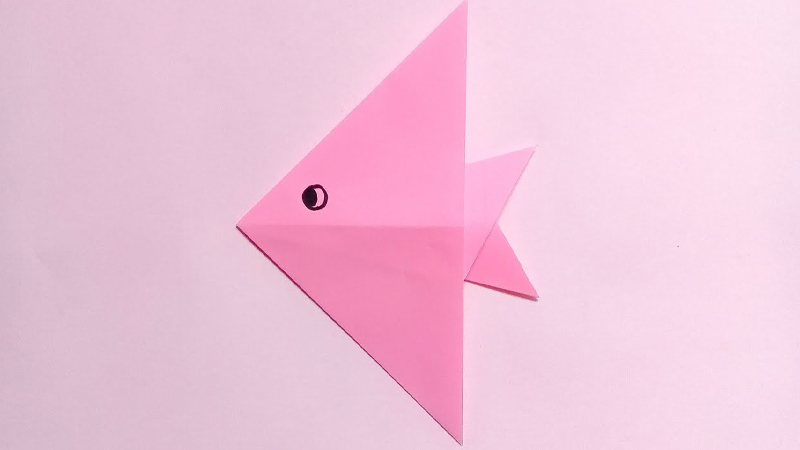
History of Origami Fish
Origami, the traditional Japanese art of paper folding, has a rich history dating back centuries. While the exact origins of the origami fish are challenging to pinpoint, it is believed to have emerged alongside the broader practice of origami itself.
Early Origins
Origami likely originated in Japan during the Edo period (1603-1868), although paper folding techniques also existed in China and Europe. However, in Japan, origami flourished as a unique art form with its distinct styles and conventions.
Symbolism and Tradition
In Japanese culture, fish hold special significance. They are often associated with perseverance, determination, and good fortune.
This symbolism extends to origami, where the folding of fish shapes has been incorporated into various ceremonial and decorative practices.
Traditional Techniques
Historically, origami was passed down orally and through hands-on instruction, with skilled practitioners teaching their techniques to apprentices.
Designs for origami fish were likely transmitted similarly, evolving through experimentation and innovation within the origami community.
Popularization and Modernization
The modernization of origami began in the late 19th and early 20th centuries with the publication of instructional books and the establishment of formal origami organizations.
These resources helped standardize techniques and popularize origami designs, including the fish.
Contemporary Significance
Today, origami fish remain popular motifs in both traditional and contemporary origami practice. They are featured in various art exhibitions, cultural events, and educational programs worldwide, symbolizing creativity, cultural heritage, and artistic expression.
Types of Origami Fish
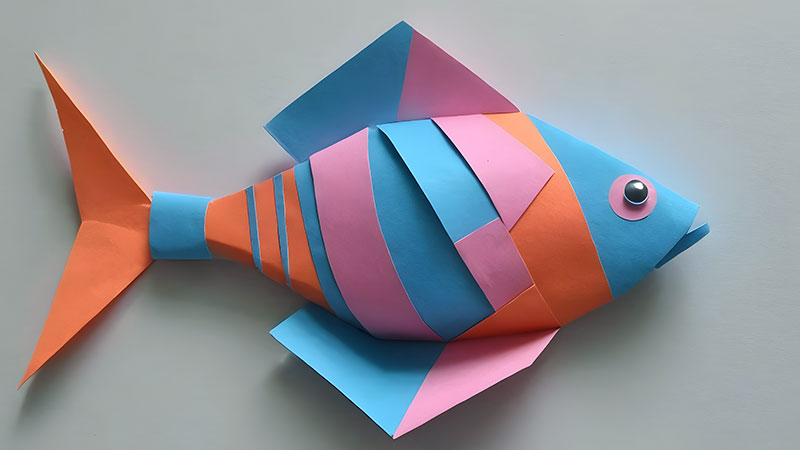
There are numerous types of origami fish, each with complexity and charm. Here are some popular ones:
Traditional Origami Fish
This is the quintessential origami fish design, known for its simplicity and ease of folding. It’s often one of the first origami models beginners learn, representing prosperity and abundance in many cultures.
Koi Fish Origami
The Koi fish is a popular motif in Japanese culture, symbolizing love, friendship, and perseverance. The origami version of the Koi fish features intricate folds and details, making it a challenging yet rewarding project for intermediate folders.
Angelfish Origami
This origami model captures the essence of the elegant angelfish with its unique shape and patterned design.
Like its real-life counterpart, the paper angelfish is eye-catching and visually appealing, making it a standout piece among origami creations.
Siamese Fighting Fish (Betta Fish) Origami
The Betta fish model offers a challenge for advanced folders with its elaborate fin structure and intricate details.
Like the real Siamese Fighting Fish, this origami version showcases the beauty and complexity of the species, making it a true masterpiece in paper form.
Pufferfish Origami
The pufferfish model adds a touch of whimsy to origami fish. While it may not puff up like its live counterpart, folding a paper pufferfish is guaranteed to be a fun experience.
With its cute and charming appearance, the pufferfish model is a favorite among beginners and experienced folders.
Popular Origami Fish Designs
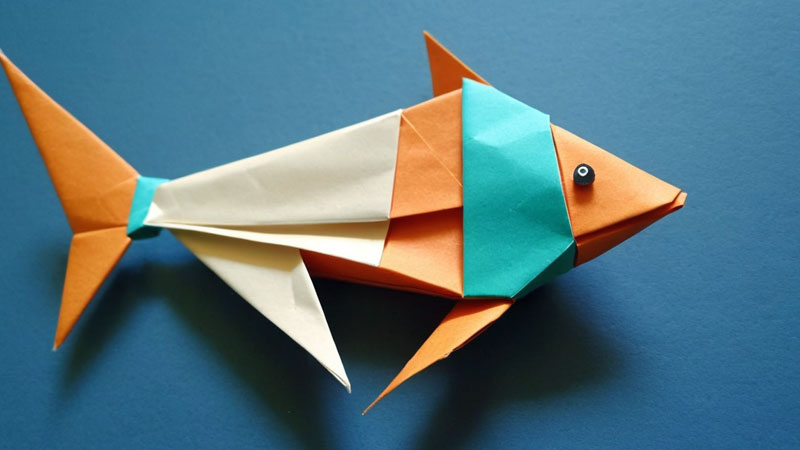
Origami has a rich tradition of fish designs, each with charm and symbolism. Here are some popular origami fish designs:
Simple Origami Fish
This design is easy to make and a great starting point for beginners. With just a few folds, you can transform a square sheet of paper into a simple fish shape.
Koi Fish
The Koi fish is a favorite among origami enthusiasts due to its intricate design and lifelike appearance. This model often requires more advanced folding techniques to create details such as scales and flowing fins.
Pufferfish
Unlike most flat origami models, the Pufferfish design stands out with its three-dimensional shape. Its adorable round form adds charm to its appeal, making it a popular choice among paper folders.
Rainbow Fish
The Rainbow Fish design allows artists to get creative with colors while maintaining simplicity in technique. Vibrant colors and a streamlined shape often characterize this design.
Tips and Techniques for Folding Origami Fish
Folding origami fish requires attention to detail and practice. Here are some tips and techniques to help you master the art:
Choose the Right Paper
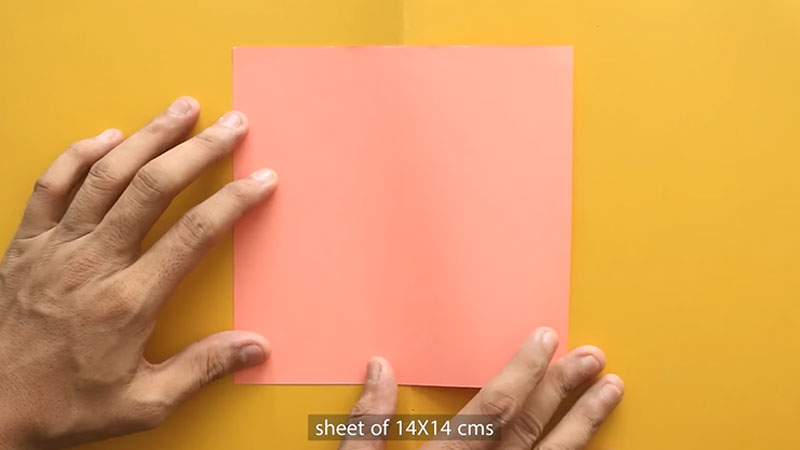
Use lightweight origami paper, which is easier to manipulate without tearing. Larger sheets are recommended for beginners until you become more comfortable with folding.
Understand Folding Techniques
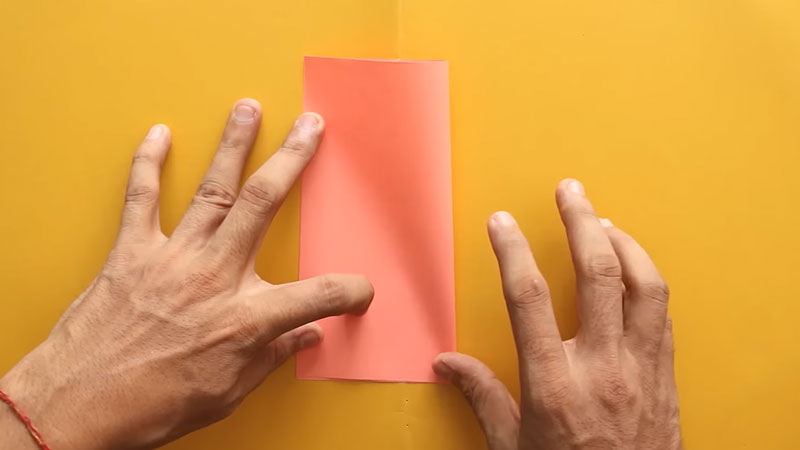
- Mountain Folds: Fold the paper back on itself to create a peak resembling a mountain.
- Valley Folds: Fold the paper inward, creating a valley or depression.
- Pleats: Make multiple folds close together, creating a series of ridges and valleys.
- Reverse Folds: Invert existing folds to create additional layers or shapes.
Practice Techniques Separately
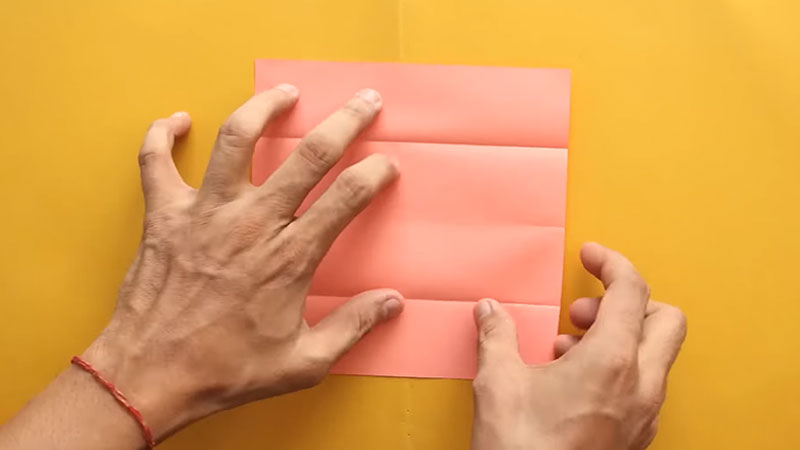
Before starting your project, practice each folding technique separately to become familiar with them and improve your precision.
Start from the Head
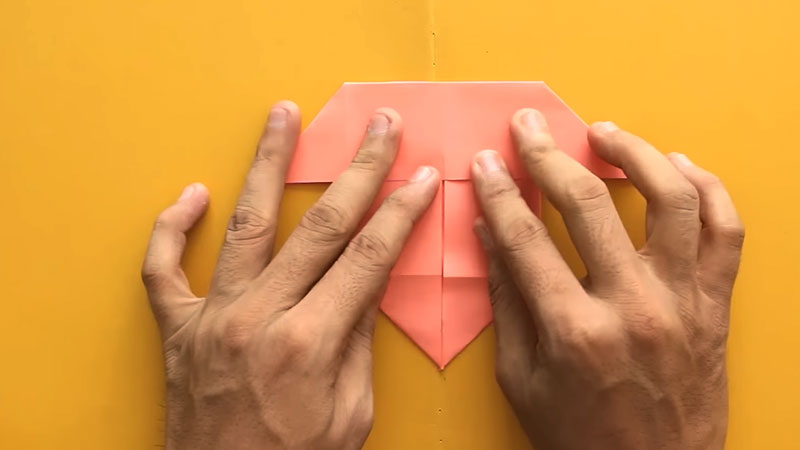
When folding the fish, begin with the head as it often requires more intricate folds for details such as eyes and mouth.
Be Patient and Persistent
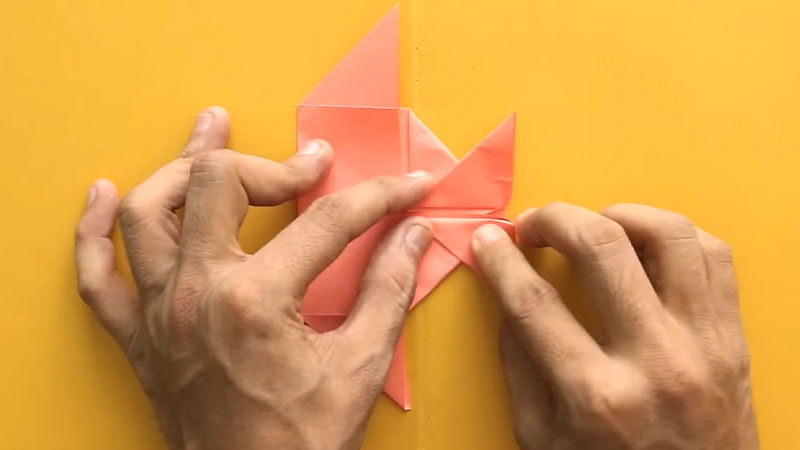
Remember that perfection comes with practice. Your first few attempts may not be as expected but don’t get discouraged. Keep practicing and experimenting with different methods until you find what works best for you.
Explore Online Resources
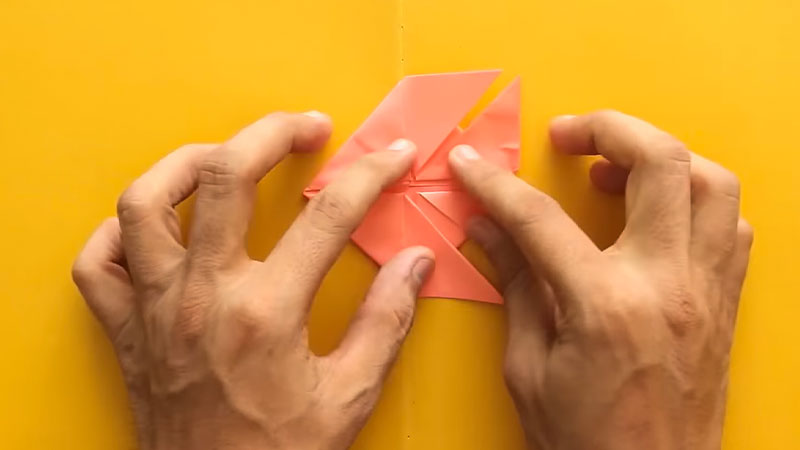
Take advantage of online tutorials, diagrams, and videos to learn new techniques and refine your skills. Online communities and forums can also provide valuable tips and support from fellow origami enthusiasts.
Enjoy the Process
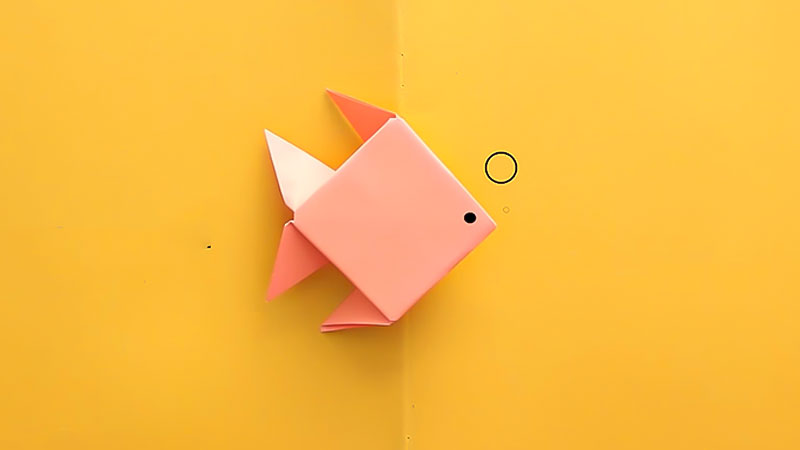
Origami is not just about the result but also about enjoying folding and creating. Embrace origami’s meditative and calming aspects as you work on your fish designs.
Creative Uses for Origami Fish
Origami fish offer a myriad of creative uses beyond being delightful paper creations. Here are some inventive ways to utilize them:
Educational Tools for Children
Origami fish serve as engaging teaching aids for children, combining the fun of crafting with learning about marine life and developing fine motor skills. Kids can fold their schools of fish, bringing lessons on biology and creativity to life.
Event Decorations
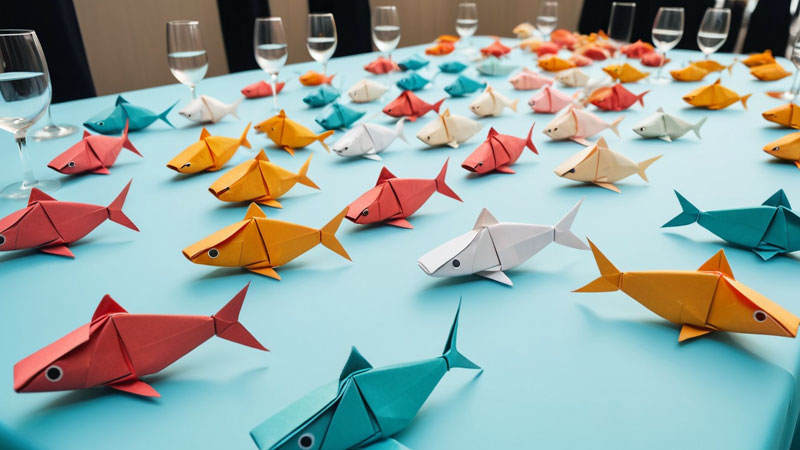
Origami fish can elevate event decor, adding a whimsical touch to summer parties or nautical-themed weddings.
Hanging strings of colorful fish from ceilings or incorporating them into centerpieces creates visually stunning and conversation-worthy displays.
Gift Tags and Greeting Cards
Replace store-bought gift tags and greeting cards with personalized origami fish creations. Adding a handcrafted touch to gifts enhances their sentimentality, and with practice, you can create intricate designs on larger paper for unique greeting cards.
Therapeutic Activities
Engage in mindfulness exercises and stress relief techniques by folding origami fish. The repetitive nature of folding paper promotes focus and calmness, providing a relaxing outlet for winding down after a long day.
Art Installations and Displays
Create striking art installations or displays using origami fish. Arrange them in visually captivating patterns or suspend them from wires to evoke a sense of movement and fluidity, transforming any space into a tranquil underwater scene.
Interactive Learning Materials
Design interactive learning materials or storybooks featuring origami fish characters. Use them to illustrate narratives, teach mathematical concepts, or facilitate language development, making learning more engaging and memorable for students of all ages.
Community Engagement Projects
Organize community engagement projects involving origami fish workshops. Collaborate with local schools, libraries, or community centers to host events where participants can learn to fold fish while fostering creativity and social connections.
Conclusion
So, what does an origami fish mean? Throughout this journey, I’ve explored the art of creating a beautiful origami fish. It’s not just about folding a piece of paper into the shape of a marine creature. Instead, it represents much more.
Diving deeper into its symbolism, an origami fish stands for prosperity and good luck in many cultures. It’s often seen as a symbol of abundance and wealth.
In Japan, where the art form originated, these delightful paper creations are given as gifts or used as decorative elements during festivals to invite blessings and fortune.
But there’s more to it than just symbolism. The act of making an origami fish is also therapeutic for many. Focusing on every crease and fold can be meditative and help reduce stress levels.
It’s truly fascinating how something so simple can have such profound meanings attached to it. From being a symbol of wealth and good fortune to serving as an effective stress reliever – that’s quite significant for a humble folded piece of paper!
Ultimately, whether crafting one for fun or with specific intentions in mind, creating an origami fish is like embarking on your artistic journey – one that brings mindfulness and joy along the way.
Leave a Reply